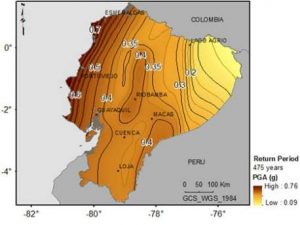
A doctoral thesis developed at UPM analysed the seismic danger of Ecuador, obtaining maximum values in Esmeraldas province, which was most heavily affected by the earthquake that took place the last 16th April.
The 7.8 magnitude earthquake that took place last Saturday, 16th April in Esmeraldas province (Ecuador), confirms a well-known fact: That the high seismic risk in that region of the Pacific Ocean is associated with the convergence of Nazca and Southamerica plates.
ON 22 February, Lieutenant Colonel Humberto Parra Cárdenas read his doctoral thesis at the Universidad Politécnica de Madrid (UPM), titled “Methodological Developments and Applications to the Calculation of the Seismic Riskness in Continental Ecuador and Study of the Seismic Risk in Quito City”.
The thesis, marked with a cum laude distinction, provided an Ecuador risk map, among other results, observing that Esmeraldas province, which has been the most affected area by the recent earthquake, is the most dangerous territory.
The map developed in this study might have important applications to seismic risk mitigation in Ecuador, suggesting two kinds of measures. On one hand, the seismic-resistant design of buildings to withstand the expected movement (shown in the map) and, on the other hand, risk studies of future earthquakes to create emergency plans, explains the thesis director, Mª Belén Benito.
Nowadays, prevention and contingency measures are the most effective to prevent and/or alleviate the disaster in seismic situations, due to the fact that they can’t be avoided or predicted in a short-term period, adds the UPM professor.
The study from this doctoral thesis has also been accepted for publication in the scientific journal Bulletin of European Earthquake Engineering.
Note: The above post is reprinted from materials provided by Universidad Politécnica de Madrid.










